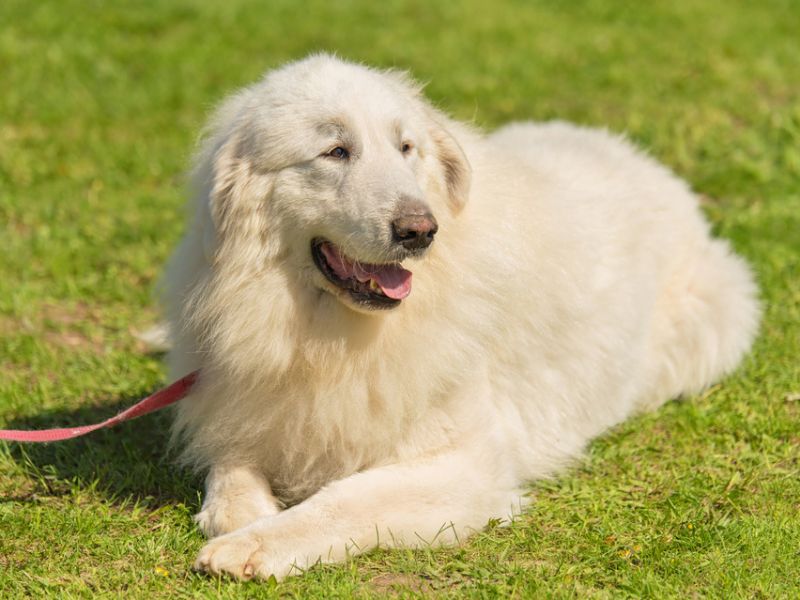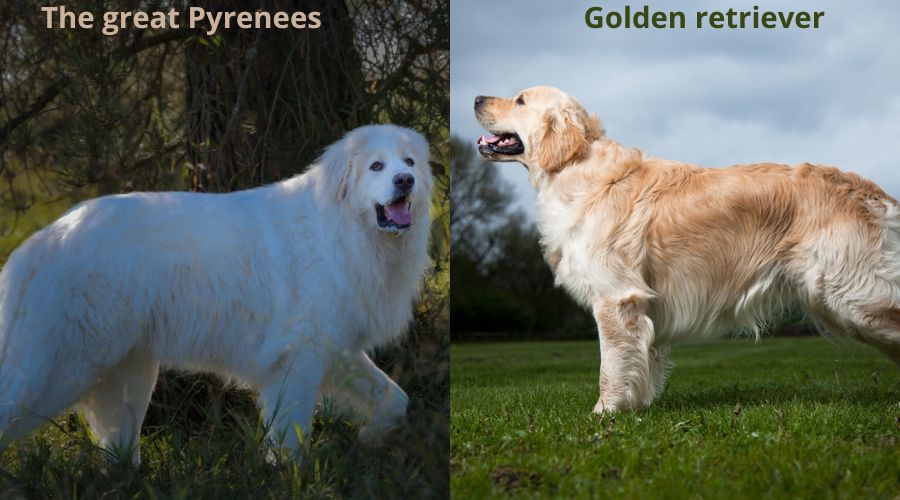There are several differences between the Great Pyrenees and Golden Retrievers. The easiest way to distinguish the two dogs is their coat color. As the name suggests, the Golden Retriever has a Golden coat. On the other hand, the Great Pyrenees has a white coat with markings of various colors like tan, red, or grey.
Another key difference between the Great Pyrenees and the Golden Retriever is size. According to the American Kennel Club (AKC), Pyrenees can grow to between 25 and 32 inches tall, and the Golden Retriever to about 21 to 24 inches.
The Pyrenees can weigh 100 pounds, and the Golden Retriever weighs 75 pounds. The dogs also vary in temperament, care, and trainability. I’ve explained more of the differences between the Great Pyrenees and Golden Golden Retrievers below in this article. You will also learn about the various health issues associated with each dog and its lifespan.
Is the Great Pyrenees similar to a golden retriever?

Yes. The Great Pyrenees and the Golden Retriever are more similar than you imagined. The most significant similarity between the two dogs is that they are both large. However, the Pyrenees are more gigantic than the Goldies.
Another similarity between Great Pyrenees and Golden Retrievers is that they have a waterproof coat. The coat forms a protective barrier against rain, snow, and the sun. In other words, their thick coat can regulate their body temperature during summer and winter.
As much as they are similar, the dogs also have many differences.
Great Pyrenees vs. Golden Retriever Dog Differences

Here are the key differences between the Great Pyrenees and Golden Retrievers.
1. Lifespan
The Great Pyrenees can live for 10-12 years. In contrast, the Golden Retriever can live for about 12 years. However, several things can influence their lifespan.
For instance, the dog’s genetics is essential to how long it will live. Therefore, ask for the Golden Retriever’s or Great Pyrs’ medical history before buying or adopting.
Nutrition is also essential for your dog to live longer. If you starve your Golden Retriever or Golden Pyr, they will not live to their 12-year lifespan. Veterinary doctors advise feeding the dogs at least twice every day.
Some quality dog foods that will increase the lifespan of Golden Retrievers and Great Pyrenees are lean meat or commercial foods like Purina Pro Plan Adult Dry Dog Food. Although nutrition is essential, don’t overfeed the dogs to avoid potential health issues.
2. Trainability
The great Pyrenees are more difficult to train than Golden Retrievers.
The Pyrenees need experienced dog owners for regular training. It needs to train for about 90 minutes daily. Lack of exercise promotes laziness in the Great Pyrenees and results in the development of bad habits. The bad habits include chewing furniture, digging, and barking excessively.
Therefore, Great Pyrenees are not suitable for first-time dog owners. The Great Pyrenees needs a firm owner who will exercise and train it. Not exercising the dog can result in severe health issues. Help your Pyrenees avoid muscular atrophy and obesity by regular exercise.
On the other hand, the Golden Retriever is easy to train. They are more intelligent, calm, and less independent dogs. The dog requires 20-30 minutes of exercise twice a day.
Golden Retrievers are loyal and happy dogs who will go the extra mile to please their owners by taking their pieces of training seriously. To train the Golden Retriever, make the session fun and rewarding. For instance, teach the dog “sit,” “drop it,” and “catch.”
3. Physical differences

The easiest way to differentiate between Golden Retrievers and Great Pyrenees is by looking at their physical differences.
First, the great Pyrenees and Golden Retriever have different coats. The Pyrenees have thick, white, fluffy coats. Although their dominant coat color is white, it may have various markings such as red, tan, badger, or grey.
On the other hand, the golden Retriever’s coat colors occur in Golden shades. Their fur could be golden, light golden, or dark golden.
The coat color for Great Pyrenees and Golden Retrievers differ only in color but are usually of the same length. Their dense coats keep their bodies warm in winter and cool them in summer.
4. Size and Weight
The Great Pyrenees is relatively large than a Golden Retriever. Male and female Pyrenees can grow up to 27 to 32 inches tall and 25 to 29 inches tall, respectively. Also, according to the American Kennel Club (AKC), adult male Pyrenees weigh about 100 lbs, and females weigh about 85 lbs.
On the other hand, male and female Goldens weigh 65 to 75 lbs, 23 to 24 inches tall, and 55 to 65 lbs, 21.5 to 22.5 inches tall, respectively.
You can calculate the weight or height of your puppy, Retrievers or Pyrenees, when they are six weeks old. Divide the puppy’s current weight by six weeks and multiply the result by 52 weeks (1 year). That is how big your Golden Retriever or Great Pyrenees will be in adulthood.
Use the same formula to approximate your dog’s height. Seek veterinary services if the weight and size of your Golden Retriever or Great Pyrenees are not within the range recommended by the American Kennel Club.
5. Temperament
Shepherds used the great Pyrenees to guard their flock. That gave Great Prys a nocturnal nature, manifesting as frequent barks at night. Thus, Great Pyrenees can be pretty aggressive to strangers or other pets.
The Great Pyrenees is confident, affectionate, calm, and gentle, while Golden Retrievers are playful and kind to all family members and visitors.
Goldens also need more attention and can be stressed if less attention is given to them. They are more likely to suffer from separation anxiety than Great Pyrenees.
6. Care
Caring for Golden Retrievers and Great Pyrenees depends on your experience with dogs. As explained earlier, Pyrs need experienced dog owners. Therefore, caring for them is also much more difficult.
Special care is needed when raising a Golden Retriever. Please do not allow your puppy to play on hard surfaces until their bones or joints are fully formed. Keep the dog on a diet rich in essential nutrients such as proteins, fiber, vitamins, and minerals.
Caring for Golden Retrievers also involves exercising the dog to keep it fit and healthy. They are more likely to join you for jogging, hiking, and biking. Regularly exercising your Golden Retriever will keep it calm and relaxed. Exercise the dog for at least one hour daily.
7. Grooming
Grooming the Great Pyrenees or Golden Retrievers is not difficult. Remember that grooming time is also the perfect time to look for any health issues in your dog.
You need only ½ an hour weekly for their grooming.
- Use clippers to trim their forelegs, feet, whiskers, and hooks.
- Brush your dog’s teeth 2-3 times weekly to reduce plaque build-up and bad breath.
- Bathe your Great Pyr or Golden Retriever using high-quality dog shampoo to soften, hydrate, and heal the dog’s skin.
- Use a dog brush or a FURminator to remove dead hair on your dog.
Health issues

Great Pyrennes and Golden Retrievers are all healthy breeds. However, they can be prone to some dog diseases.
The great Pyrenees may suffer from gastric torsion, otitis externa, and spinal muscular atrophy. It is also vulnerable to serious health problems such as canine hip dysplasia.
Golden Retrievers often suffer from cancer, heart problems, and hip and elbow dysplasia.
Here is the summary of the differences between the Great Pyrenees and Golden Retrievers:
| Differences | The great Pyrenees | Golden Retriever |
| Lifespan (years) | 10-12 | 12 |
| Size (Inches) | 27-32 (Male)25-29 (Female) | 23-24 (Male) 21.5-22.5 (Female) |
| Weight (Pounds) | 100 (Male)85 (Female) | 65-75 (Male)55-65 (Female) |
| Trainability | Difficult to train | Easy to train |
| Physical appearance | Dominant white coat with different color markings. | Golden coat |
| Temperament | Loyal and gentle, but can be aggressive to strangers | Playful and kind dogs to all family members and visitors |
Which dog to choose
Deciding which dog to own will depend on your preferences. The Great Pyrenees will be your best dog if you are a busy dog owner. Otherwise, choose the Golden Retriever if you are always in the house because the dog needs an active family for daily regular exercise.
Also, if you are a new dog owner, choose the Golden Retriever. The dog is easy to train and care for than the Great Pyrenees.
References
National PYR Rescue. (2022). Know the Breed.
Reisen, J. (2021). 10 Fun Facts About Golden Retrievers. The American Kennel Club
The American Kennel Club. (2017) Breed Weight Chart. AKC.